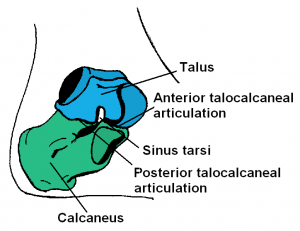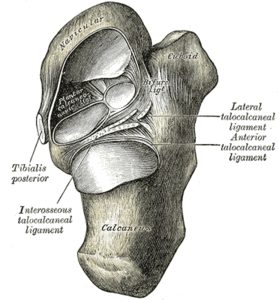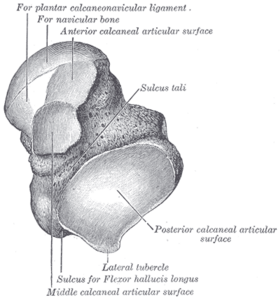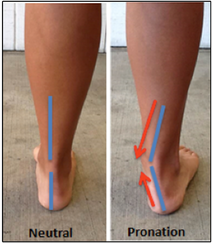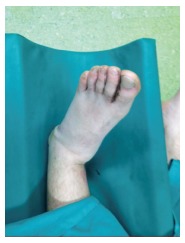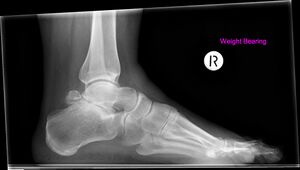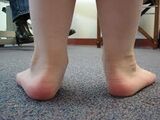Subtalar Joint: Difference between revisions
Abbey Wright (talk | contribs) (added references) |
Abbey Wright (talk | contribs) (updated evidence and formatting) |
||
| Line 6: | Line 6: | ||
== Introduction == | == Introduction == | ||
[[File:Subtalar joint.png|thumb|Subtalar joint]] | [[File:Subtalar joint.png|thumb|Subtalar joint]] | ||
The subtalar (ST) joint is an articulation between two of the tarsal bones in the foot | The subtalar (ST) joint is an articulation between two of the tarsal bones in the foot: the [[talus]] and [[calcaneus]]. The joint is classed structurally as a [[Synovial Joints|synovial joint]], and functionally as a plane synovial joint. | ||
The ST joint allows inversion and eversion of the foot. | The ST joint allows for rotation of the foot, clinically known as inversion and eversion of the foot<ref name=":0">Krähenbühl N, Horn-Lang T, Hintermann B, Knupp M. [https://eor.bioscientifica.com/view/journals/eor/2/7/2058-5241.2.160050.xml The subtalar joint: a complex mechanism]. EFORT open reviews. 2017 Jul 6;2(7):309-16.</ref>. | ||
Inversion and eversion allows<ref>Brukner P et al. Brukner & Khan's Clinical Sports medicine 5th edition. Sydney, Australia: Mc Graw hill education; 2017. p893-895</ref>: | Inversion and eversion allows<ref>Brukner P et al. Brukner & Khan's Clinical Sports medicine 5th edition. Sydney, Australia: Mc Graw hill education; 2017. p893-895</ref>: | ||
| Line 19: | Line 19: | ||
== Structure == | == Structure == | ||
[[File:Subtalar Joint.png|thumb|Subtalar ligaments Superior view|alt=|300x300px]] | [[File:Subtalar Joint.png|thumb|Subtalar ligaments Superior view|alt=|300x300px]] | ||
The ST joint is multi-articular joint, with three articulated facets that provide a surface for the joint to glide<ref>Rockar Jr PA. [https://www.jospt.org/doi/epdf/10.2519/jospt.1995.21.6.361 The subtalar joint: anatomy and joint motion.] Journal of Orthopaedic & Sports Physical Therapy. 1995 Jun;21(6):361-72.</ref>: | The ST joint is multi-articular joint, with three articulated facets that provide a surface for the joint to glide.<ref>Rockar Jr PA. [https://www.jospt.org/doi/epdf/10.2519/jospt.1995.21.6.361 The subtalar joint: anatomy and joint motion.] Journal of Orthopaedic & Sports Physical Therapy. 1995 Jun;21(6):361-72.</ref> The ST joint can be divided into two parts: | ||
# The anterior subtalar | # The anterior subtalar part: talar head articulating with the anterior and middle facets of the calcaneus<ref name=":0" />. Which allows glide forward (anterior articulation) | ||
# The | # The posterior subtalar part: the concave facet of the talus lies on the convex posterior facet of the calcaneus<ref name=":0" />. Which allows glide backwards (posterior articulation) | ||
[[File:Talus, seen from below.png|thumb|Talus, seen from below|alt=|300x300px]] | [[File:Talus, seen from below.png|thumb|Talus, seen from below|alt=|300x300px]] | ||
There are several ligaments around the subtalar joint which provide stability. They can be classified as intrinsic (cervical ligament, interosseous talo-calcaneal ligament) and extrinsic ligaments (calcaneo-fibular ligament, deltoid ligament)<ref name=":0" />. | |||
== Movements == | == Movements == | ||
The movements that occur at the subtalar joint are gliding and rotation.The combination of these movements | The movements that occur at the subtalar joint are gliding and rotation. The combination of these movements clinically are known as inversion and eversion; these are considered to be the primary movements in the subtalar joint<ref name=":0" />. | ||
# Supination in the subtalar joint is primarily produced by [[Tibialis Anterior|tibialis anterior]] and [[Tibialis Posterior|tibialis posterior]], with assistance from [[Extensor Hallucis Longus|extensor hallucis longus]], [[flexor hallucis longus]] and [[flexor digitorum longus]]. | The mechanics of the foot is not in isolation. It is accompanied by movements in the talocalcaneonavicular and calcaneocuboid joints<ref name=":1">Seringe R, Wicart P, French Society of Pediatric Orthopaedics (SOFOP. [https://www.sciencedirect.com/science/article/pii/S1877056813001254 The talonavicular and subtalar joints: the “calcaneopedal unit” concept.] Orthopaedics & Traumatology: Surgery & Research. 2013 Oct 1;99(6):S345-55.</ref>. | ||
# Pronation is mainly produced by [[Peroneus (Fibularis) Longus Muscle|fibularis longus]], [[Peroneus Brevis|fibularis brevis]] and fibularis tertius with assistance from the extrinsic muscles that extend the toes ([[Extensor Digitorum Longus|extensor digitorum longus]] and [[Extensor Hallucis Longus|extensor hallucis longus]]) | |||
# '''Supination''' in the subtalar joint is primarily produced by [[Tibialis Anterior|tibialis anterior]] and [[Tibialis Posterior|tibialis posterior]], with assistance from [[Extensor Hallucis Longus|extensor hallucis longus]], [[flexor hallucis longus]] and [[flexor digitorum longus]]. | |||
# '''Pronation''' is mainly produced by [[Peroneus (Fibularis) Longus Muscle|fibularis longus]], [[Peroneus Brevis|fibularis brevis]] and fibularis tertius with assistance from the extrinsic muscles that extend the toes ([[Extensor Digitorum Longus|extensor digitorum longus]] and [[Extensor Hallucis Longus|extensor hallucis longus]]). | |||
== Function == | == Function == | ||
[[File:Ankle Pronation Position.png|thumb|Ankle and foot in Neutral and Over-pronation|alt=|243x243px]] | [[File:Ankle Pronation Position.png|thumb|Ankle and foot in Neutral and Over-pronation|alt=|243x243px]] | ||
The ST joint is key to many functional activities | The ST joint is key to many functional activities such as walking and running. The mechanisms behind how the subtalar joint propels you us is very complex<ref name=":1" />. | ||
This ST joints primary movements involve supination, in which the foot rolls toward the body's midline, and pronation, in which the foot rolls away from the midline. Both of these movements require a combination of distinct actions. | This ST joints primary movements involve supination, in which the foot rolls toward the body's midline, and pronation, in which the foot rolls away from the midline. Both of these movements require a combination of distinct actions. | ||
* Pronation requires a combination of dorsiflexion, abduction, and eversion. | * Pronation requires a combination of dorsiflexion, abduction, and eversion. | ||
* Supination requires a combination of plantar flexion, adduction and inversion | * Supination requires a combination of plantar flexion, adduction and inversion | ||
== Physiotherapy Relevance == | == Physiotherapy Relevance == | ||
[[File:Subtalar dislocation.jpg|thumb|Medial ST dislocation]] | [[File:Subtalar dislocation.jpg|thumb|Medial ST dislocation]] | ||
The subtalar joint is essential for mobility, and as such is prone to | The subtalar joint is essential for mobility, and as such is prone to degeneration as with every weight bearing joint, trauma, and joint-specific disorders such as instability<ref name=":0" />. Any damage done to the subtalar joint and surrounding soft tissues that support it may lead to pain, foot deformity (often permanent), and affect gait and mobility. Conditions affecting this joint include the below: | ||
[[File:Subtalar-osteoarthritis.jpeg|thumb|Subtalar-osteoarthritis]] | [[File:Subtalar-osteoarthritis.jpeg|thumb|Subtalar-osteoarthritis]] | ||
'''Directly Joint Related''' | '''Directly Joint Related''' | ||
# [[Juvenile Rheumatoid Arthritis]]: The subtalar joint is often the first joint affected | # [[Juvenile Rheumatoid Arthritis]]: The subtalar joint is often the first joint affected | ||
# [[Subtalar Joint Arthritis|Osteoarthritis]] | # [[Subtalar Joint Arthritis|Osteoarthritis]] | ||
# [[Rheumatoid Arthritis|Rheumatoid arthritis]]: Primarily attacks joint tissues, often the ankle and foot | # [[Calcaneal Fractures|Calcaneal fracture]] (subtalar joint is usually disrupted, causing the joint to become arthritic). | ||
#[[Rheumatoid Arthritis|Rheumatoid arthritis]]: Primarily attacks joint tissues, often the ankle and foot | |||
# Instability of the ST joint. | |||
# [[Subtalar dislocation]] occurs through the disruption of 2 separate bony articulations, the talonavicular and talocalcaneal joints | |||
[[File:Download (2).jpg|thumb|Pes Planus|alt=|160x160px]] | [[File:Download (2).jpg|thumb|Pes Planus|alt=|160x160px]] | ||
# [[Pes cavus]]/[[Pes Planus|Pes planus]] | |||
'''Disorders in which the subtalar joint is indirectly affected or affected as a result of another defect or injury to the foot or ankle:''' | |||
# [[Chronic Ankle Instability]] | |||
# [[Tarsal Coalition|Tarsal coalition]] | #[[Pes cavus]]/[[Pes Planus|Pes planus]] | ||
# [[Sinus Tarsi Syndrome|Sinus tarsi syndrome]] | #[[Chronic Ankle Instability]] | ||
#[[Tarsal Coalition|Tarsal coalition]] | |||
#[[Sinus Tarsi Syndrome|Sinus tarsi syndrome]] | |||
== References == | == References == | ||
Revision as of 10:40, 8 September 2022
Original Editor - Lucinda hampton
Top Contributors - Lucinda hampton, Vidya Acharya, Abbey Wright and Kim Jackson
Introduction[edit | edit source]
The subtalar (ST) joint is an articulation between two of the tarsal bones in the foot: the talus and calcaneus. The joint is classed structurally as a synovial joint, and functionally as a plane synovial joint.
The ST joint allows for rotation of the foot, clinically known as inversion and eversion of the foot[1].
Inversion and eversion allows[2]:
- The foot and ankle to pivot/change directions,
- stay balanced
- walk across uneven terrain.
- act as a shock absorber
Structure[edit | edit source]
The ST joint is multi-articular joint, with three articulated facets that provide a surface for the joint to glide.[3] The ST joint can be divided into two parts:
- The anterior subtalar part: talar head articulating with the anterior and middle facets of the calcaneus[1]. Which allows glide forward (anterior articulation)
- The posterior subtalar part: the concave facet of the talus lies on the convex posterior facet of the calcaneus[1]. Which allows glide backwards (posterior articulation)
There are several ligaments around the subtalar joint which provide stability. They can be classified as intrinsic (cervical ligament, interosseous talo-calcaneal ligament) and extrinsic ligaments (calcaneo-fibular ligament, deltoid ligament)[1].
Movements[edit | edit source]
The movements that occur at the subtalar joint are gliding and rotation. The combination of these movements clinically are known as inversion and eversion; these are considered to be the primary movements in the subtalar joint[1].
The mechanics of the foot is not in isolation. It is accompanied by movements in the talocalcaneonavicular and calcaneocuboid joints[4].
- Supination in the subtalar joint is primarily produced by tibialis anterior and tibialis posterior, with assistance from extensor hallucis longus, flexor hallucis longus and flexor digitorum longus.
- Pronation is mainly produced by fibularis longus, fibularis brevis and fibularis tertius with assistance from the extrinsic muscles that extend the toes (extensor digitorum longus and extensor hallucis longus).
Function[edit | edit source]
The ST joint is key to many functional activities such as walking and running. The mechanisms behind how the subtalar joint propels you us is very complex[4].
This ST joints primary movements involve supination, in which the foot rolls toward the body's midline, and pronation, in which the foot rolls away from the midline. Both of these movements require a combination of distinct actions.
- Pronation requires a combination of dorsiflexion, abduction, and eversion.
- Supination requires a combination of plantar flexion, adduction and inversion
Physiotherapy Relevance[edit | edit source]
The subtalar joint is essential for mobility, and as such is prone to degeneration as with every weight bearing joint, trauma, and joint-specific disorders such as instability[1]. Any damage done to the subtalar joint and surrounding soft tissues that support it may lead to pain, foot deformity (often permanent), and affect gait and mobility. Conditions affecting this joint include the below:
Directly Joint Related
- Juvenile Rheumatoid Arthritis: The subtalar joint is often the first joint affected
- Osteoarthritis
- Calcaneal fracture (subtalar joint is usually disrupted, causing the joint to become arthritic).
- Rheumatoid arthritis: Primarily attacks joint tissues, often the ankle and foot
- Instability of the ST joint.
- Subtalar dislocation occurs through the disruption of 2 separate bony articulations, the talonavicular and talocalcaneal joints
Disorders in which the subtalar joint is indirectly affected or affected as a result of another defect or injury to the foot or ankle:
References[edit | edit source]
- ↑ 1.0 1.1 1.2 1.3 1.4 1.5 Krähenbühl N, Horn-Lang T, Hintermann B, Knupp M. The subtalar joint: a complex mechanism. EFORT open reviews. 2017 Jul 6;2(7):309-16.
- ↑ Brukner P et al. Brukner & Khan's Clinical Sports medicine 5th edition. Sydney, Australia: Mc Graw hill education; 2017. p893-895
- ↑ Rockar Jr PA. The subtalar joint: anatomy and joint motion. Journal of Orthopaedic & Sports Physical Therapy. 1995 Jun;21(6):361-72.
- ↑ 4.0 4.1 Seringe R, Wicart P, French Society of Pediatric Orthopaedics (SOFOP. The talonavicular and subtalar joints: the “calcaneopedal unit” concept. Orthopaedics & Traumatology: Surgery & Research. 2013 Oct 1;99(6):S345-55.
